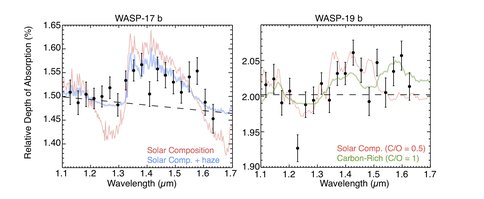2013 Annual Science Report
 NASA Goddard Space Flight Center
Reporting | SEP 2012 – AUG 2013
NASA Goddard Space Flight Center
Reporting | SEP 2012 – AUG 2013
Exploring the Chemical Composition of Hot Exoplanets With the Hubble Space Telescope
Project Summary
We have used the new Wide Field Camera 3 (WFC3) instrument on the Hubble Space Telescope (HST) to observe exoplanet transit and eclipse measurements for a number of highly irradiated, Jupiter-mass planets, with a focus on confirming which planets exhibit water absorption in transit and/or eclipse and measuring the characteristic brightness temperature at these wavelengths. Measurements of molecular absorption in the atmospheres of these planets offer the chance to explore several outstanding questions regarding the atmospheric structure and composition of hot Jupiters, including the possibility of bulk compositional variations between planets and the presence or absence of a stratospheric temperature inversion.
Project Progress
In this reporting period, we have focused on analyzing three exoplanets in primary transit (WASP-12b, WASP-17b, and WASP-19b) for signs of water vapor and other molecules in their atmospheres. We analyzed the data for a single primary transit of each planet with a new methodology that allows us to correct for channel– or wavelength–dependent instru-mental effects by utilizing the band-integrated time series and measurements of the drift of the spectra on the detector over time. We have developed a data reduction pipeline and analysis methodology that produces spectra with precision close to the theoretical noise floor for individual spectral bins. The final results are broadly consistent with the presence of absorption at 1.4 µm, most likely due to water, but the amplitude of the absorption was less than that expected based on previous observations with Spitzer – possibly due to hazes absorbing in the Near InfraRed (NIR) or to non-solar compositions.
For WASP-17b the water signal was clear, but for the two other planets the degeneracy of models with different compositions and temperature structures combined with the low amplitude of any features in the data precluded our ability to place unambiguous constraints on the atmospheric composition. More sensitive observations with WFC3 and/or a comprehensive multi-wavelength analysis are planned. A paper detailing our efforts and results has been published (Mandell et al. 2013), and some of our data analysis strategies were also incorporated into a related publication (Deming et al. 2013).
Publications
-
Deming, D., Wilkins, A., McCullough, P., Burrows, A., Fortney, J. J., Agol, E., … Showman, A. P. (2013). INFRARED TRANSMISSION SPECTROSCOPY OF THE EXOPLANETS HD 209458b AND XO-1b USING THE WIDE FIELD CAMERA-3 ON THE HUBBLE SPACE TELESCOPE. The Astrophysical Journal, 774(2), 95. doi:10.1088/0004-637x/774/2/95
-
Mandell, A. M., Haynes, K., Sinukoff, E., Madhusudhan, N., Burrows, A., & Deming, D. (2013). EXOPLANET TRANSIT SPECTROSCOPY USING WFC3: WASP-12 b, WASP-17 b, AND WASP-19 b. The Astrophysical Journal, 779(2), 128. doi:10.1088/0004-637x/779/2/128
-
PROJECT INVESTIGATORS:
-
PROJECT MEMBERS:
Avi Mandell
Project Investigator
Adam Burrows
Collaborator
Drake Deming
Collaborator
Korey Haynes
Collaborator
Nikku Madhusudhan
Collaborator
Evan Sinukoff
Collaborator
-
RELATED OBJECTIVES:
Objective 1.1
Formation and evolution of habitable planets.
Objective 1.2
Indirect and direct astronomical observations of extrasolar habitable planets.
Objective 7.2
Biosignatures to be sought in nearby planetary systems
